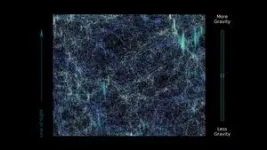(Press-News.org) Gravity has shaped our cosmos. Its attractive influence turned tiny differences in the amount of matter present in the early universe into the sprawling strands of galaxies we see today. A new study using data from the Dark Energy Spectroscopic Instrument (DESI) has traced how this cosmic structure grew over the past 11 billion years, providing the most precise test to date of gravity at very large scales.
DESI is an international collaboration of more than 900 researchers from over 70 institutions around the world and is managed by the Department of Energy’s Lawrence Berkeley National Laboratory (Berkeley Lab). In their new study, DESI researchers found that gravity behaves as predicted by Einstein’s theory of general relativity. The result validates our leading model of the universe and limits possible theories of modified gravity, which have been proposed as alternative ways to explain unexpected observations – including the accelerating expansion of our universe that is typically attributed to dark energy.
“General relativity has been very well tested at the scale of solar systems, but we also needed to test that our assumption works at much larger scales,” said Pauline Zarrouk, a cosmologist at the French National Center for Scientific Research (CNRS) working at the Laboratory of Nuclear and High-Energy Physics (LPNHE), who co-led the new analysis. “Studying the rate at which galaxies formed lets us directly test our theories and, so far, we’re lining up with what general relativity predicts at cosmological scales.”
The study also provided new upper limits on the mass of neutrinos, the only fundamental particles whose masses have not yet been precisely measured. Previous neutrino experiments found that the sum of the masses of the three types of neutrinos should be at least 0.059 eV/c2. (For comparison, an electron has a mass of about 511,000 eV/c2.) DESI’s results indicate that the sum should be less than 0.071 eV/c2, leaving a narrow window for neutrino masses.
The DESI collaboration shared their results in several papers posted to the online repository arXiv today. The complex analysis used nearly 6 million galaxies and quasars and lets researchers see up to 11 billion years into the past. With just one year of data, DESI has made the most precise overall measurement of the growth of structure, surpassing previous efforts that took decades to make.
Today’s results provide an extended analysis of DESI’s first year of data, which in April made the largest 3D map of our universe to date and revealed hints that dark energy might be evolving over time. The April results looked at a particular feature of how galaxies cluster known as baryon acoustic oscillations (BAO). The new analysis, called a “full-shape analysis,” broadens the scope to extract more information from the data, measuring how galaxies and matter are distributed on different scales throughout space. The study required months of additional work and cross-checks. Like the previous study, it used a technique to hide the result from the scientists until the end, mitigating any unconscious bias.
“Both our BAO results and the full-shape analysis are spectacular,” said Dragan Huterer, professor at the University of Michigan and co-lead of DESI’s group interpreting the cosmological data. “This is the first time that DESI has looked at the growth of cosmic structure. We’re showing a tremendous new ability to probe modified gravity and improve constraints on models of dark energy. And it’s only the tip of the iceberg.”
DESI is a state-of-the-art instrument that can capture light from 5,000 galaxies simultaneously. It was constructed and is operated with funding from the DOE Office of Science. DESI is mounted on the U.S. National Science Foundation’s Nicholas U. Mayall 4-meter Telescope at Kitt Peak National Observatory (a program of NSF NOIRLab). The experiment is now in its fourth of five years surveying the sky and plans to collect roughly 40 million galaxies and quasars by the time the project ends.
The collaboration is currently analyzing the first three years of collected data and expects to present updated measurements of dark energy and the expansion history of our universe in spring 2025. DESI’s expanded results released today are consistent with the experiment’s earlier preference for an evolving dark energy, adding to the anticipation of the upcoming analysis.
“Dark matter makes up about a quarter of the universe, and dark energy makes up another 70 percent, and we don’t really know what either one is,” said Mark Maus, a PhD student at Berkeley Lab and UC Berkeley who worked on theory and validation modeling pipelines for the new analysis. “The idea that we can take pictures of the universe and tackle these big, fundamental questions is mind-blowing.”
DESI is supported by the DOE Office of Science and by the National Energy Research Scientific Computing Center, a DOE Office of Science user facility. Additional support for DESI is provided by the U.S. National Science Foundation; the Science and Technology Facilities Council of the United Kingdom; the Gordon and Betty Moore Foundation; the Heising-Simons Foundation; the French Alternative Energies and Atomic Energy Commission (CEA); the National Council of Humanities, Sciences, and Technologies of Mexico; the Ministry of Science and Innovation of Spain; and by the DESI member institutions.
The DESI collaboration is honored to be permitted to conduct scientific research on I’oligam Du’ag (Kitt Peak), a mountain with particular significance to the Tohono O’odham Nation.
###
Lawrence Berkeley National Laboratory (Berkeley Lab) is committed to delivering solutions for humankind through research in clean energy, a healthy planet, and discovery science. Founded in 1931 on the belief that the biggest problems are best addressed by teams, Berkeley Lab and its scientists have been recognized with 16 Nobel Prizes. Researchers from around the world rely on the lab’s world-class scientific facilities for their own pioneering research. Berkeley Lab is a multiprogram national laboratory managed by the University of California for the U.S. Department of Energy’s Office of Science.
DOE’s Office of Science is the single largest supporter of basic research in the physical sciences in the United States, and is working to address some of the most pressing challenges of our time. For more information, please visit energy.gov/science.
END
A University of Texas at Dallas physicist and his international colleagues in the Dark Energy Spectroscopic Instrument (DESI) collaboration are engaged in a multiyear data-gathering mission to try to answer one of the most puzzling observations in astrophysics: Why does the expansion of the universe appear to be accelerating?
Competing theories have attempted to explain this observation. One is that dark energy is somehow pushing galaxies apart. A second theory posits that gravity, the attractive force that in local environments like the solar system draws objects together, works differently at large cosmological scales and needs to be modified to explain cosmic ...
A new report from the Bankwest Curtin Economics Centre reveals Western Australia’s startup and innovation ecosystem requires targeted reforms and investment to unlock its full potential, calling for improvements in talent development, gender diversity and access to capital and infrastructure to support a more diversified economy.
The report, titled ‘Dare to Venture: Startups and the innovation ecosystem in Western Australia’, highlights WA’s strengths in mining, ...
Des Plaines, IL – A new study exploring the use of cranial accelerometry (CA) headsets for the prehospital detection of large-vessel occlusion (LVO) strokes has been published in a recent issue of Academic Emergency Medicine (AEM), the peer-reviewed journal of the Society for Academic Emergency Medicine (SAEM).
LVO strokes, which represent one-third of acute ischemic stroke (AIS) cases in the United States, are responsible for two-thirds of poststroke dependence and 90% of poststroke mortality. The introduction of endovascular thrombectomy (EVT) over the past decade has significantly advanced the management of LVO strokes, emphasizing ...
High cardiorespiratory fitness is associated with better cognitive performance and lower risk of dementia long term, including in people with a genetic predisposition to dementia, show the findings of a study published online in the British Journal of Sports Medicine.
Cardiorespiratory fitness (CRF) is the capacity of the circulatory and respiratory systems to supply oxygen to muscles and declines increasingly with age as skeletal muscle is lost. CRF declines by around 3% to 6% per decade when people are in their 20s and 30s, but this accelerates to more than 20% per decade by the time people reach their 70s. Low CRF is a strong predictor of cardiovascular ...
The number and type of microbes present in the saliva of pregnant women differ according to whether they are experiencing life stress and symptoms of anxiety, depression and post-traumatic stress disorder (PTSD), finds a study published in the open access journal BMJ Mental Health.
Although several studies have shown links between the diversity of microbes in the gastrointestinal tract and stress, anxiety and depression in pregnant women and new mothers, no previous study has looked at the association between the type and number of microorganisms in the mouth and throat—oral microbiome—and ...
PHOENIX, November 19, 2024 — The American Heart Association and the Arizona Cardinals gathered representatives from 12 local schools for cardiopulmonary resuscitation (CPR) and automated external defibrillator (AED) training on Nov. 18 at Pima Elementary School in Scottsdale. According to American Heart Association data, Nearly 9 out of 10 people who experience cardiac arrest outside of a hospital die, in part because they do not receive immediate CPR more than half of the time. CPR, especially if performed immediately, can double or triple a person’s chance of survival.
“Early ...
UNDER STRICT EMBARGO UNTIL 00:01AM (UK TIME) ON WEDNESDAY 20TH NOVEMBER 2024
People from Glasgow, Belfast, Dublin and the north-east of England are better at detecting someone imitating their accent than people from London and Essex, new research from the University of Cambridge has found.
People from Belfast proved most able to detect someone faking their accent, while people from London, Essex and Bristol were least accurate.
The study, published today in Evolutionary Human Sciences found that the ability of participants ...
Trust between humans and robots is improved when the movement between both is harmonised, researchers have discovered.
These findings could improve the success of real-world human-robot teams, helping users like the emergency services to work more effectively with robots in the future.
By sensing co-movement in real-world environments, robots could use this as an indicator to sense whether the user trusts them sufficiently.
Lead author Dr Edmund Hunt, based in the University of Bristol’s Faculty of Science and Engineering, said: “People have preferred social distances from others during interaction and ...
In the Making Sense of Science series – launched today (20 November) by Frontiers’ Policy Labs in partnership with the International Science Council (ISC) – world leading scientists, including scientific experts and knowledge brokers from the ISC Fellowship, give insights into how science should be understood by the public and applied to policies that affect societies worldwide.
In the face of global threats – health crises, climate change, war – we need political will, global collaboration, inter- and transdisciplinary approaches, systems ...
A collaboration between The Wistar Institute and the University of Buea in Cameroon has uncovered the mechanisms for a medicinal plant with anti-HIV potential in Croton oligandrus Pierre & Hutch, a species of African tree that has been used in traditional healing in Cameroon to treat a variety of diseases and conditions including cancers and diabetes.
The research team — a collaboration between Fidele Ntie-Kang, Ph.D., an Associate Professor of Pharmaceutical Sciences at the University of Buea and the Director of the University of Buea Centre for Drug Discovery, and Ian Tietjen, Ph.D., Assistant Professor and Education Director of Global Studies & ...




